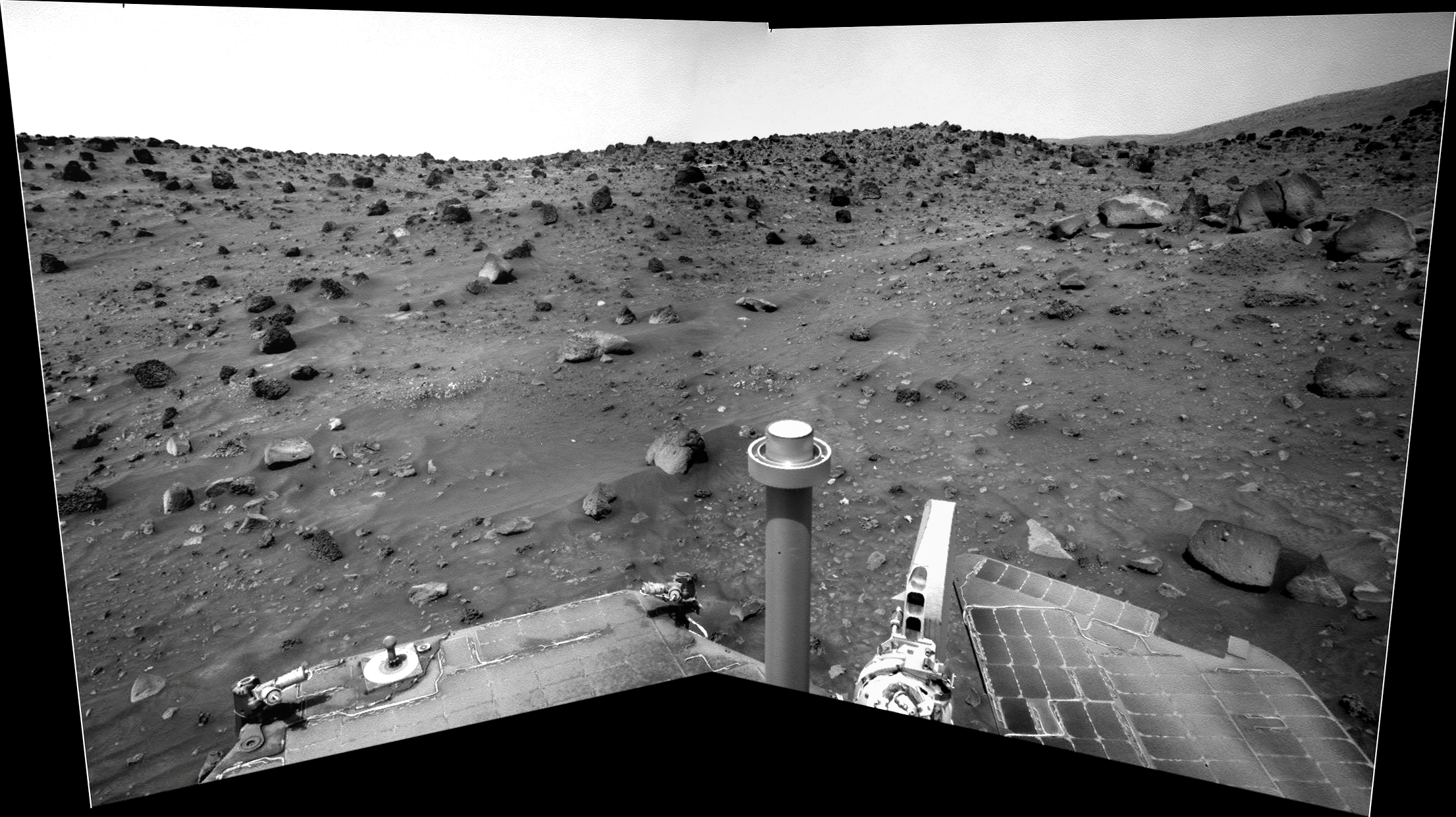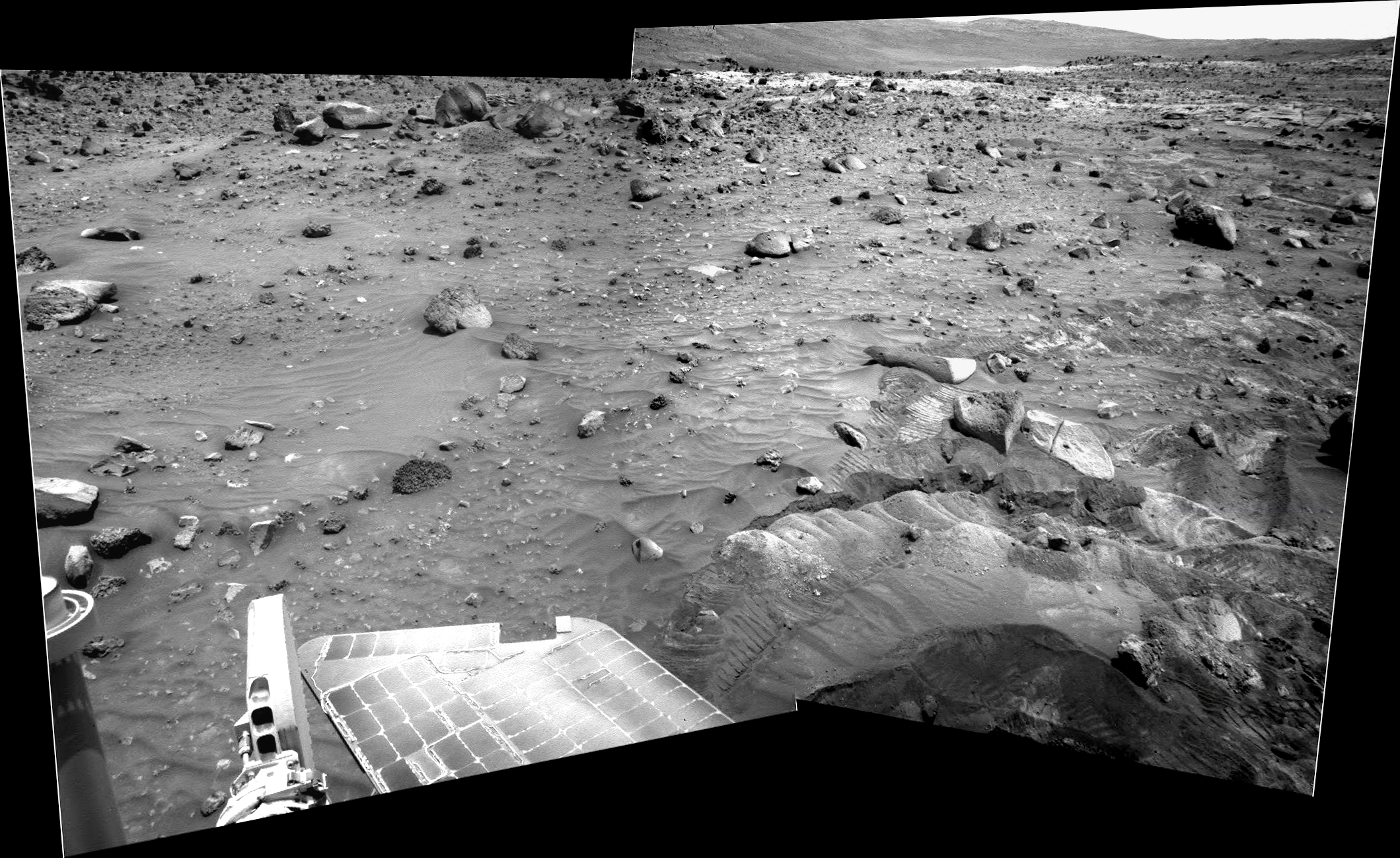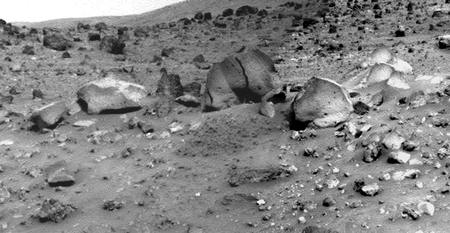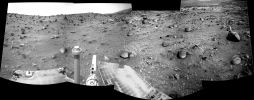It looks like you're using an Ad Blocker.
Please white-list or disable AboveTopSecret.com in your ad-blocking tool.
Thank you.
Some features of ATS will be disabled while you continue to use an ad-blocker.
share:
a reply to: Arken
Yeah, that's what the "eyes" look like. Clear that the angle is different, though. I didn't check his later "creature" image, but I suspect it's the same sort of thing. If not, anyone feel free to post stills showing that.
Overall, the "lizard" stuff was more believable. At least the rocks did look a lot like lizards!
Yeah, that's what the "eyes" look like. Clear that the angle is different, though. I didn't check his later "creature" image, but I suspect it's the same sort of thing. If not, anyone feel free to post stills showing that.
Overall, the "lizard" stuff was more believable. At least the rocks did look a lot like lizards!
Wow, so much time and debate wasted on a simple misunderstanding of the perspective or parallax!
So let me waste a bit more. The fact that the rover moved and changed its angle of view, is more easily seen when you stitch the individual images into panoramas, which provides the context of the terrain.
Sol 1833:

Sol 1843:

Gif:

Sol 1833 full panorama:

Sol 1843 full panorama:

So let me waste a bit more. The fact that the rover moved and changed its angle of view, is more easily seen when you stitch the individual images into panoramas, which provides the context of the terrain.
Sol 1833:

Sol 1843:

Gif:

Sol 1833 full panorama:

Sol 1843 full panorama:

edit on 20-5-2014 by wildespace because: (no reason given)
a reply to: wildespace
So, in summary, after six pages, we have learnt that sometimes rocks can be hidden behind other rocks.
So, in summary, after six pages, we have learnt that sometimes rocks can be hidden behind other rocks.
Getting a little tired of seeing "Hard evidence of life on Mars" threads then finding out that there isn't any hard evidence. I think that's
because most people don't realize what "hard evidence" actually means. "Hard evidence" is not the opinion of some YT uploader, some random
before/after pictures implying something moved, Pareidolia or even some spot on the lens that people insist are UFO's or aliens or whatever.
You'll never get "hard evidence" from a Rover moving about the surface taking pictures all over the place.
You'll never get "hard evidence" from a Rover moving about the surface taking pictures all over the place.
originally posted by: Rob48
a reply to: wildespace
So, in summary, after six pages, we have learnt that sometimes rocks can be hidden behind other rocks.
Correct.
And, if you move your head a little (or in this case, if you move the camera a little), then you may see the rock hidden behind the other.
originally posted by: LadyGreenEyes
a reply to: Arken
Yeah, that's what the "eyes" look like. Clear that the angle is different, though. I didn't check his later "creature" image, but I suspect it's the same sort of thing. If not, anyone feel free to post stills showing that.
Overall, the "lizard" stuff was more believable. At least the rocks did look a lot like lizards!
Did you say Mars lizard? Meet my find, a little rocky lizard-shape direct from the Red Planet:

originally posted by: Chamberf=6
a reply to: tsingtao
To imagine like a cartoon instead of working off of what is known so far?
yeah, just like that.
what exactly IS known?
originally posted by: wildespace
Wow, so much time and debate wasted on a simple misunderstanding of the perspective or parallax!
So let me waste a bit more. The fact that the rover moved and changed its angle of view, is more easily seen when you stitch the individual images into panoramas, which provides the context of the terrain.
Sol 1833:
Sol 1843:
Gif:
Sol 1833 full panorama:

Sol 1843 full panorama:
yeah, you figured it all out, except the the tail.
you do see the tail, right?
originally posted by: tsingtao
originally posted by: wildespace
Wow, so much time and debate wasted on a simple misunderstanding of the perspective or parallax!
So let me waste a bit more. The fact that the rover moved and changed its angle of view, is more easily seen when you stitch the individual images into panoramas, which provides the context of the terrain.
Sol 1833:
Sol 1843:
Gif:
Sol 1833 full panorama:

Sol 1843 full panorama:
yeah, you figured it all out, except the the tail.
you do see the tail, right?
Where's the tail? Can you post a picture? Or at least give directions? I see lots of rocks, but rocks don't have tails.
a reply to: netbound
a reply to: Phage
a reply to: ArMaP
a reply to: bhornbuckle75
Hey guys, just wanted to pop back in to say I was wrong. Totally wrong. I said the rock would rotate to the left, but it does indeed rotate behind our original rock.
Also, I should've noticed just how far the background was off between our two SOL pics.
Only took me 3 days and a few hours.
I swear I'm not stupid....
a reply to: Phage
a reply to: ArMaP
a reply to: bhornbuckle75
Hey guys, just wanted to pop back in to say I was wrong. Totally wrong. I said the rock would rotate to the left, but it does indeed rotate behind our original rock.
Also, I should've noticed just how far the background was off between our two SOL pics.
Only took me 3 days and a few hours.
I swear I'm not stupid....
originally posted by: ArMaP
These photos again?
They were discussed on ATS some years ago, and as we can see from the animation posted by Phage it's just a question of perspective.
It's amazing how many people are incapable of understanding perspective.
I remember that discussion and there have been others since. Many times people do not have all the information, if they are shown only some, it is easy to be misled. Camera perspective can be a difficult thing, it really can fool you sometimes... even the people who know a lot about it.
originally posted by: Rob48
a reply to: anonentity
Concord travelled at Mach 2 approx. the airframe increased the length of the aircraft by 6 to 8 inches.
Concorde was travelling through Earth's atmosphere.
Why are you arguing that the people who designed the braking system didn't know their job?
The parachute was designed to fire 11.8km above the surface, where the temperature is about minus 70 degrees C. It was 14.1 metres in diameter and designed to generate a peak braking force on Mars of more than 78,000 newtons. Before the mission it was tested on Earth to approximately 144% of this figure.
Which parts of this do you have a problem with?
The problem I have is the massive heat generated , if I have said anything illogical i'm sorry. But by questioning we learn.
a reply to: anonentity
But there's not massive heat generated. The Martian atmosphere is a LOT thinner so there is a lot less friction.
On Earth you can pull open a parachute at freefall speeds, say 120mph, and your parachute doesn't heat up and melt, and that is in an atmosphere more than 100 times denser.
So why should a parachute opening at less than 10 times the speed do so in the much thinner (and colder) Martian atmosphere?
But there's not massive heat generated. The Martian atmosphere is a LOT thinner so there is a lot less friction.
On Earth you can pull open a parachute at freefall speeds, say 120mph, and your parachute doesn't heat up and melt, and that is in an atmosphere more than 100 times denser.
So why should a parachute opening at less than 10 times the speed do so in the much thinner (and colder) Martian atmosphere?
a reply to: anonentity
But the heat generated at Mach 1.7 in the martian atmosphere is anything but massive.
Concorde flew through much thicker atmosphere at those speeds here on Earth.
The parachute, just like the rest of the rover and skycrane, did NOT undergo massive heating during the atmospheric entry. That is what the heat shield was for (hence the name Heat Shield).
The parachute was not deployed until the rover had dropped to a speed of Mach 1.7. The parachute was designed for these speeds so it would not shred.
Bottom line: the parachute was never exposed to "massive heat".
But the heat generated at Mach 1.7 in the martian atmosphere is anything but massive.
Concorde flew through much thicker atmosphere at those speeds here on Earth.
The parachute, just like the rest of the rover and skycrane, did NOT undergo massive heating during the atmospheric entry. That is what the heat shield was for (hence the name Heat Shield).
The parachute was not deployed until the rover had dropped to a speed of Mach 1.7. The parachute was designed for these speeds so it would not shred.
Bottom line: the parachute was never exposed to "massive heat".
a reply to: eriktheawful
At 11.8 km in Mars' atmosphere M1.7 corresponds to a speed of 800 mph.
www.grc.nasa.gov...
But the heat generated at Mach 1.7 in the martian atmosphere is anything but massive.
At 11.8 km in Mars' atmosphere M1.7 corresponds to a speed of 800 mph.
www.grc.nasa.gov...
edit on 5/20/2014 by Phage because: (no reason given)
originally posted by: Phage
a reply to: eriktheawful
But the heat generated at Mach 1.7 in the martian atmosphere is anything but massive.
At 11.8 km in Mars' atmosphere M1.7 corresponds to a speed of 800 mph.
www.grc.nasa.gov...
Yep, and that is nowhere near fast enough to generate enough friction heat to melt anything.
I don't know if anyone mentioned this yet but there is a rock that is in photo 4 that disappears in photo 5, its easy to see. Its a black rock between
the 2 larger ones on the left. You can see it well at 9:40 in the video.
edit on 20-5-2014 by lotusfoot because: (no reason
given)
edit on 20-5-2014 by lotusfoot because: (no reason given)
a reply to: Aleister
That's the one! Most likely just rocks, but at least there, the thing discussed looks like something other than a blob.
When I first caught this thread, I couldn't help but chuckle, and debate whether or not to speculate on whether moon rocks migrated to Mars.
That's the one! Most likely just rocks, but at least there, the thing discussed looks like something other than a blob.
When I first caught this thread, I couldn't help but chuckle, and debate whether or not to speculate on whether moon rocks migrated to Mars.
new topics
-
Judge rules president-elect Donald Trump must be sentenced in 'hush money' trial
US Political Madness: 3 hours ago -
Farmers wife
Music: 5 hours ago -
NJ Drones tied to Tesla explosion at Trump Las vegas
General Conspiracies: 6 hours ago -
New Jersey-Teachers Can Now Be Certified Without Passing Basic Reading Writing Math Testing
Education and Media: 9 hours ago
top topics
-
Matthew Livelsberger said he was being followed by FBI
Political Conspiracies: 12 hours ago, 16 flags -
Here we again... CHINA having mass outbreak of something
Diseases and Pandemics: 16 hours ago, 9 flags -
The 119th Congress has Officially Opened for Business
Mainstream News: 15 hours ago, 7 flags -
New Jersey-Teachers Can Now Be Certified Without Passing Basic Reading Writing Math Testing
Education and Media: 9 hours ago, 7 flags -
Paranoid Liberals Believe U.S. Service Members are More Dangerous than Illegal Aliens.
Social Issues and Civil Unrest: 15 hours ago, 6 flags -
How the Sikhs Deal with Muslim Grooming Gangs – Tommy Robinson
Social Issues and Civil Unrest: 14 hours ago, 6 flags -
NJ Drones tied to Tesla explosion at Trump Las vegas
General Conspiracies: 6 hours ago, 3 flags -
Farmers wife
Music: 5 hours ago, 1 flags -
Judge rules president-elect Donald Trump must be sentenced in 'hush money' trial
US Political Madness: 3 hours ago, 0 flags
active topics
-
Judge rules president-elect Donald Trump must be sentenced in 'hush money' trial
US Political Madness • 4 • : Lazy88 -
Paranoid Liberals Believe U.S. Service Members are More Dangerous than Illegal Aliens.
Social Issues and Civil Unrest • 31 • : Irishhaf -
Candidate TRUMP Now Has Crazy Judge JUAN MERCHAN After Him - The Stormy Daniels Hush-Money Case.
Political Conspiracies • 2173 • : WeMustCare -
Tesla Cybertruck Explodes in Front of Trump Hotel in Las Vegas
Mainstream News • 198 • : Mantiss2021 -
Matthew Livelsberger said he was being followed by FBI
Political Conspiracies • 63 • : BeyondKnowledge3 -
Musk calls on King Charles III to dissolve Parliament over Oldham sex grooming gangs
Mainstream News • 88 • : WeMustCare -
-@TH3WH17ERABB17- -Q- ---TIME TO SHOW THE WORLD--- -Part- --44--
Dissecting Disinformation • 3923 • : RelSciHistItSufi -
Watts home paranormal activity
Paranormal Studies • 6 • : TowmasterLG -
Congress Says the FBI is Covering Up Vital Info on the Jan 5th 2021 D.C. Pipe Bombs at RNC-DNC.
Political Conspiracies • 28 • : GotterDameron23 -
New Jersey-Teachers Can Now Be Certified Without Passing Basic Reading Writing Math Testing
Education and Media • 9 • : rickymouse
